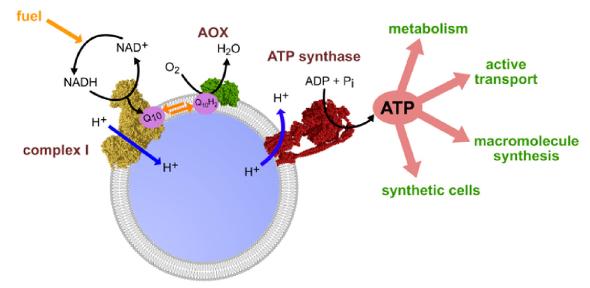
Submitted by Penny Peck on Tue, 16/06/2020 - 00:00
The results of a research project entitled, “Bottom-Up Construction of a Minimal System for Cellular Respiration and Energy Regeneration” have been published in ACS Synthetic Biology.
This research was carried out at the MBU, in the Complex I Group, led by Professor Judy Hirst. It describes the bottom-up assembly and characterization of a minimal respiratory system that uses NADH as a fuel to produce ATP, and is thus capable of sustaining both upstream metabolic processes that rely on NAD+, and downstream energy-demanding processes that are powered by ATP hydrolysis.
Eukaryotic cells are powered by their mitochondria. A set of enzymes, located in the mitochondrial inner membrane, catalyse the redox-driven formation of an electrochemical proton gradient, which is dissipated to generate ATP from ADP and inorganic phosphate. The ATP pool is used to drive a plethora of biochemical reactions within the cell. One of the major contemporary goals of biology is to create artificial cells that mimic natural cells, but that are assembled from their individual components.
In this project, a detergent-mediated approach was used to co-reconstitute respiratory mitochondrial complex I and an F-type ATP synthase into nanosized liposomes. Addition of the alternative oxidase to the resulting proteoliposomes produced a minimal artificial “organelle” that reproduces the energy-converting catalytic reactions of the mitochondrial respiratory chain: NADH oxidation, ubiquinone cycling, oxygen reduction, proton pumping, and ATP synthesis.
The synthetic minimal organelle has been demonstrated to sustain ATP synthesis for several hours using an NAD+-linked substrate by following the cell-free production of a fluorescent protein. The ability to provide a constant supply of ATP is crucial for the bottom-up construction of artificial cells and therefore these synthetic organelles may be applied to power artificial cells in future work.

